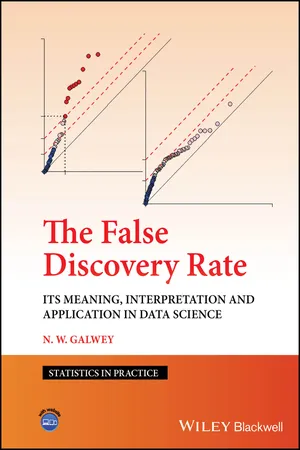
The False Discovery Rate
Its Meaning, Interpretation and Application in Data Science
- English
- PDF
- Available on iOS & Android
About this book
The False Discovery Rate
An essential tool for statisticians and data scientists seeking to interpret the vast troves of data that increasingly power our world
First developed in the 1990s, the False Discovery Rate (FDR) is a way of describing the rate at which null hypothesis testing produces errors. It has since become an essential tool for interpreting large datasets. In recent years, as datasets have become ever larger, and as the importance of 'big data' to scientific research has grown, the significance of the FDR has grown correspondingly.
The False Discovery Rate provides an analysis of the FDR's value as a tool, including why it should generally be preferred to the Bonferroni correction and other methods by which multiplicity can be accounted for. It offers a systematic overview of the FDR, its core claims, and its applications.
Readers of The False Discovery Rate will also find:
- Case studies throughout, rooted in real and simulated data sets
- Detailed discussion of topics including representation of the FDR on a Q–Q plot, consequences of non-monotonicity, and many more
- Wide-ranging analysis suited for a broad readership
The False Discovery Rate is ideal for Statistics and Data Science courses, and short courses associated with conferences. It is also useful as supplementary reading in courses in other disciplines that require the statistical interpretation of 'big data'. The book will also be of great value to statisticians and researchers looking to learn more about the FDR.
STATISTICS IN PRACTICE
A series of practical books outlining the use of statistical techniques in a wide range of applications areas:
- HUMAN AND BIOLOGICAL SCIENCES
- EARTH AND ENVIRONMENTAL SCIENCES
- INDUSTRY, COMMERCE AND FINANCE
Frequently asked questions
- Essential is ideal for learners and professionals who enjoy exploring a wide range of subjects. Access the Essential Library with 800,000+ trusted titles and best-sellers across business, personal growth, and the humanities. Includes unlimited reading time and Standard Read Aloud voice.
- Complete: Perfect for advanced learners and researchers needing full, unrestricted access. Unlock 1.4M+ books across hundreds of subjects, including academic and specialized titles. The Complete Plan also includes advanced features like Premium Read Aloud and Research Assistant.
Please note we cannot support devices running on iOS 13 and Android 7 or earlier. Learn more about using the app.
Information
Table of contents
- Cover
- Series Page
- Title Page
- Copyright Page
- Contents
- Preface and Acknowledgement
- About the Companion Website
- Chapter 1 Introduction
- Chapter 2 The Meaning of the False Discovery Rate (FDR)
- Chapter 3 Graphical Presentation of the FDR
- Chapter 4 Application of the FDR to Multiple Hypothesis Testing in Real-World Data
- Chapter 5 Alternative Approaches to the Multiple-Testing Problem
- Chapter 6 The FDR in the Context of Bayesian Statistics
- Chapter 7 Alternative Specifications of the FDR
- Chapter 8 The FDR in Relation to an 'Uninteresting' Rather Than a Null Hypothesis
- Chapter 9 Supplementation of p-Values with an Auxiliary Covariate: The Conditional FDR (cFDR)
- Chapter 10 An FDR-Based Analogue of the Confidence Interval: The False Coverage Rate (FCR)
- Chapter 11 The FDR as a Criterion for Sample Size Calculations
- Index
- Eula